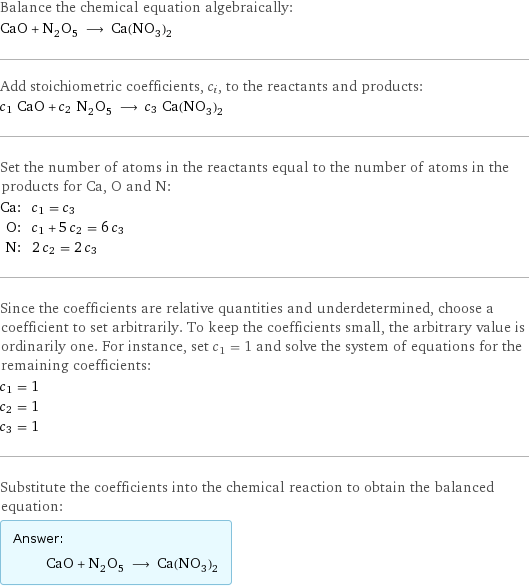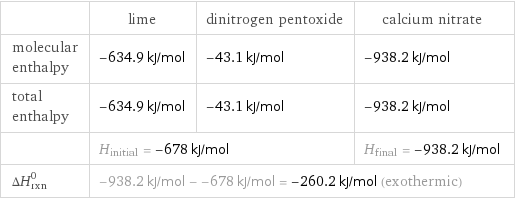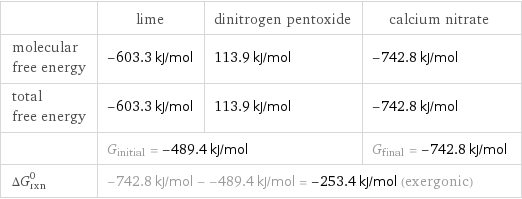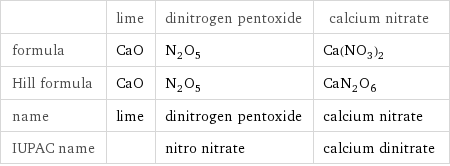Input interpretation

CaO lime + N_2O_5 dinitrogen pentoxide ⟶ Ca(NO_3)_2 calcium nitrate
Balanced equation

Balance the chemical equation algebraically: CaO + N_2O_5 ⟶ Ca(NO_3)_2 Add stoichiometric coefficients, c_i, to the reactants and products: c_1 CaO + c_2 N_2O_5 ⟶ c_3 Ca(NO_3)_2 Set the number of atoms in the reactants equal to the number of atoms in the products for Ca, O and N: Ca: | c_1 = c_3 O: | c_1 + 5 c_2 = 6 c_3 N: | 2 c_2 = 2 c_3 Since the coefficients are relative quantities and underdetermined, choose a coefficient to set arbitrarily. To keep the coefficients small, the arbitrary value is ordinarily one. For instance, set c_1 = 1 and solve the system of equations for the remaining coefficients: c_1 = 1 c_2 = 1 c_3 = 1 Substitute the coefficients into the chemical reaction to obtain the balanced equation: Answer: | | CaO + N_2O_5 ⟶ Ca(NO_3)_2
Structures

+ ⟶
Names

lime + dinitrogen pentoxide ⟶ calcium nitrate
Reaction thermodynamics
Enthalpy

| lime | dinitrogen pentoxide | calcium nitrate molecular enthalpy | -634.9 kJ/mol | -43.1 kJ/mol | -938.2 kJ/mol total enthalpy | -634.9 kJ/mol | -43.1 kJ/mol | -938.2 kJ/mol | H_initial = -678 kJ/mol | | H_final = -938.2 kJ/mol ΔH_rxn^0 | -938.2 kJ/mol - -678 kJ/mol = -260.2 kJ/mol (exothermic) | |
Gibbs free energy

| lime | dinitrogen pentoxide | calcium nitrate molecular free energy | -603.3 kJ/mol | 113.9 kJ/mol | -742.8 kJ/mol total free energy | -603.3 kJ/mol | 113.9 kJ/mol | -742.8 kJ/mol | G_initial = -489.4 kJ/mol | | G_final = -742.8 kJ/mol ΔG_rxn^0 | -742.8 kJ/mol - -489.4 kJ/mol = -253.4 kJ/mol (exergonic) | |
Equilibrium constant
![Construct the equilibrium constant, K, expression for: CaO + N_2O_5 ⟶ Ca(NO_3)_2 Plan: • Balance the chemical equation. • Determine the stoichiometric numbers. • Assemble the activity expression for each chemical species. • Use the activity expressions to build the equilibrium constant expression. Write the balanced chemical equation: CaO + N_2O_5 ⟶ Ca(NO_3)_2 Assign stoichiometric numbers, ν_i, using the stoichiometric coefficients, c_i, from the balanced chemical equation in the following manner: ν_i = -c_i for reactants and ν_i = c_i for products: chemical species | c_i | ν_i CaO | 1 | -1 N_2O_5 | 1 | -1 Ca(NO_3)_2 | 1 | 1 Assemble the activity expressions accounting for the state of matter and ν_i: chemical species | c_i | ν_i | activity expression CaO | 1 | -1 | ([CaO])^(-1) N_2O_5 | 1 | -1 | ([N2O5])^(-1) Ca(NO_3)_2 | 1 | 1 | [Ca(NO3)2] The equilibrium constant symbol in the concentration basis is: K_c Mulitply the activity expressions to arrive at the K_c expression: Answer: | | K_c = ([CaO])^(-1) ([N2O5])^(-1) [Ca(NO3)2] = ([Ca(NO3)2])/([CaO] [N2O5])](../image_source/47838160eb0b464d211ca5eec0e8f48a.png)
Construct the equilibrium constant, K, expression for: CaO + N_2O_5 ⟶ Ca(NO_3)_2 Plan: • Balance the chemical equation. • Determine the stoichiometric numbers. • Assemble the activity expression for each chemical species. • Use the activity expressions to build the equilibrium constant expression. Write the balanced chemical equation: CaO + N_2O_5 ⟶ Ca(NO_3)_2 Assign stoichiometric numbers, ν_i, using the stoichiometric coefficients, c_i, from the balanced chemical equation in the following manner: ν_i = -c_i for reactants and ν_i = c_i for products: chemical species | c_i | ν_i CaO | 1 | -1 N_2O_5 | 1 | -1 Ca(NO_3)_2 | 1 | 1 Assemble the activity expressions accounting for the state of matter and ν_i: chemical species | c_i | ν_i | activity expression CaO | 1 | -1 | ([CaO])^(-1) N_2O_5 | 1 | -1 | ([N2O5])^(-1) Ca(NO_3)_2 | 1 | 1 | [Ca(NO3)2] The equilibrium constant symbol in the concentration basis is: K_c Mulitply the activity expressions to arrive at the K_c expression: Answer: | | K_c = ([CaO])^(-1) ([N2O5])^(-1) [Ca(NO3)2] = ([Ca(NO3)2])/([CaO] [N2O5])
Rate of reaction
![Construct the rate of reaction expression for: CaO + N_2O_5 ⟶ Ca(NO_3)_2 Plan: • Balance the chemical equation. • Determine the stoichiometric numbers. • Assemble the rate term for each chemical species. • Write the rate of reaction expression. Write the balanced chemical equation: CaO + N_2O_5 ⟶ Ca(NO_3)_2 Assign stoichiometric numbers, ν_i, using the stoichiometric coefficients, c_i, from the balanced chemical equation in the following manner: ν_i = -c_i for reactants and ν_i = c_i for products: chemical species | c_i | ν_i CaO | 1 | -1 N_2O_5 | 1 | -1 Ca(NO_3)_2 | 1 | 1 The rate term for each chemical species, B_i, is 1/ν_i(Δ[B_i])/(Δt) where [B_i] is the amount concentration and t is time: chemical species | c_i | ν_i | rate term CaO | 1 | -1 | -(Δ[CaO])/(Δt) N_2O_5 | 1 | -1 | -(Δ[N2O5])/(Δt) Ca(NO_3)_2 | 1 | 1 | (Δ[Ca(NO3)2])/(Δt) (for infinitesimal rate of change, replace Δ with d) Set the rate terms equal to each other to arrive at the rate expression: Answer: | | rate = -(Δ[CaO])/(Δt) = -(Δ[N2O5])/(Δt) = (Δ[Ca(NO3)2])/(Δt) (assuming constant volume and no accumulation of intermediates or side products)](../image_source/0089f42f9b3f193938e910e0f3b3852d.png)
Construct the rate of reaction expression for: CaO + N_2O_5 ⟶ Ca(NO_3)_2 Plan: • Balance the chemical equation. • Determine the stoichiometric numbers. • Assemble the rate term for each chemical species. • Write the rate of reaction expression. Write the balanced chemical equation: CaO + N_2O_5 ⟶ Ca(NO_3)_2 Assign stoichiometric numbers, ν_i, using the stoichiometric coefficients, c_i, from the balanced chemical equation in the following manner: ν_i = -c_i for reactants and ν_i = c_i for products: chemical species | c_i | ν_i CaO | 1 | -1 N_2O_5 | 1 | -1 Ca(NO_3)_2 | 1 | 1 The rate term for each chemical species, B_i, is 1/ν_i(Δ[B_i])/(Δt) where [B_i] is the amount concentration and t is time: chemical species | c_i | ν_i | rate term CaO | 1 | -1 | -(Δ[CaO])/(Δt) N_2O_5 | 1 | -1 | -(Δ[N2O5])/(Δt) Ca(NO_3)_2 | 1 | 1 | (Δ[Ca(NO3)2])/(Δt) (for infinitesimal rate of change, replace Δ with d) Set the rate terms equal to each other to arrive at the rate expression: Answer: | | rate = -(Δ[CaO])/(Δt) = -(Δ[N2O5])/(Δt) = (Δ[Ca(NO3)2])/(Δt) (assuming constant volume and no accumulation of intermediates or side products)
Chemical names and formulas

| lime | dinitrogen pentoxide | calcium nitrate formula | CaO | N_2O_5 | Ca(NO_3)_2 Hill formula | CaO | N_2O_5 | CaN_2O_6 name | lime | dinitrogen pentoxide | calcium nitrate IUPAC name | | nitro nitrate | calcium dinitrate
Substance properties

| lime | dinitrogen pentoxide | calcium nitrate molar mass | 56.077 g/mol | 108.01 g/mol | 164.09 g/mol phase | solid (at STP) | solid (at STP) | solid (at STP) melting point | 2580 °C | 30 °C | 562 °C boiling point | 2850 °C | 47 °C | density | 3.3 g/cm^3 | 2.05 g/cm^3 | 2.5 g/cm^3 solubility in water | reacts | | soluble
Units
